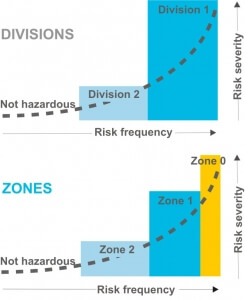Introduction to Intrinsically Safe Radios
Locations and Labels
Hazardous Location Classifications
Hazardous area classification
Hazardous area classification is required by government regulatory bodies. These areas are defined by both severity and frequency of risk. Globally, there are two main area classifications: divisions and zones.
Divisions vs Zones
Division classification is traditionally used in North America. Zone classification originated in Europe but is now adopted worldwide. While they have much in common, there is a significant difference in how they rate perceived risk, which can cause confusion.
 The Division/Zone classification determines the risk profile for an area. Intrinsically Safe equipment must pass compliance testing and will receive a rating that has a direct correlation with the division or zone classification. While each radio model has additional specifications that will be explored later, this overall rating is the first step in assessing the suitability of a radio for a specific situation.
The Division/Zone classification determines the risk profile for an area. Intrinsically Safe equipment must pass compliance testing and will receive a rating that has a direct correlation with the division or zone classification. While each radio model has additional specifications that will be explored later, this overall rating is the first step in assessing the suitability of a radio for a specific situation.
While zone classification has been adopted globally, the legacy division classification continues to be used in places like the United States. This can cause problems as equipment transitions to zone based ratings, whilst the locations the equipment is being used remains classified under divisions. For example, a product that is rated for use in Zone 1 may be considered suitable for use where there is an occasional risk present. However under division area classification, the product could only be used in a Division 2 area. In this case the division classification is too coarse.
The below shows the differences between divisions and zones:

Starting with Divisions, you will notice that fuel sources receive classification. Gas or vapours are in Class I, Dust is Class II, and Fibers are Class III. In Division 1, it is likely that materials in Class I, II, or III will be present under normal operating conditions. In Division 2, it is unlikely that materials in Class I, II, or III will be present under normal operating conditions.
With regards to Zones, if gas or vapours are present, then we need to look for certification in Zones 0, 1, or 2. If dust is present, then we need certification in Zones 20, 21, or 22. Zone 0 or Zone 20 mean that Gas or Dust will be present continuously for long periods under normal operating conditions. It’s worth noting that Zone 0 rating denotes highly-specialized equipment. Zone 1 or Zone 21 mean that Gas or Dust is likely to exist in normal operating conditions. Zone 2 or Zone 22 mean that Gas or Dust is unlikely to exist in normal operating conditions.
Lastly, Please remember that area classification must be performed only by authorized personnel.
 Radio Academy
Radio Academy




